To the Lighthouse《到灯塔去》介绍
- 格式:ppt
- 大小:727.00 KB
- 文档页数:17
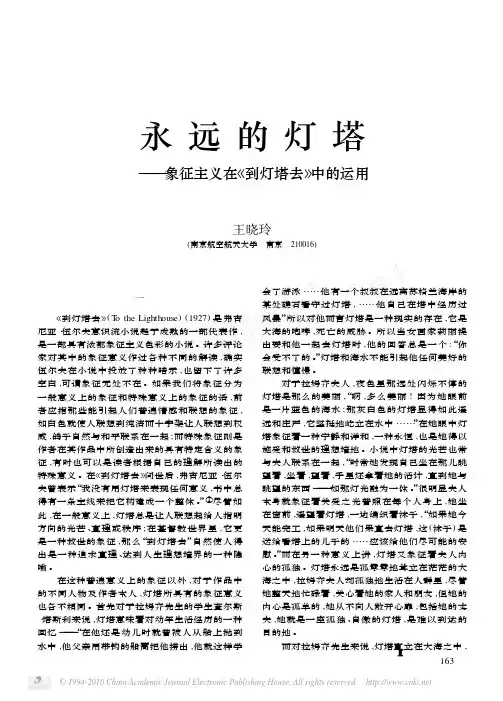
永远的灯塔———象征主义在《到灯塔去》中的运用王晓玲(南京航空航天大学 南京 210016)一《到灯塔去》(T o the Lighth ouse)(1927)是弗吉尼亚・伍尔夫意识流小说趋于成熟的一部代表作,是一部具有浓郁象征主义色彩的小说。
许多评论家对其中的象征意义作过各种不同的解读,确实伍尔夫在小说中投放了种种暗示,也留下了许多空白,可谓象征无处不在。
如果我们将象征分为一般意义上的象征和特殊意义上的象征的话,前者应指那些能引起人们普遍情感和联想的象征,如白色就使人联想到纯洁而十字架让人联想到权威,鸽子自然与和平联系在一起;而特殊象征则是作者在其作品中所创造出来的具有特定含义的象征,有时也可以是读者根据自己的理解所读出的特殊意义。
在《到灯塔去》问世后,弗吉尼亚・伍尔夫曾表示“我没有用灯塔来表现任何意义,书中总得有一条主线来把它构建成一个整体。
”①尽管如此,在一般意义上,灯塔总是让人联想起给人指明方向的光芒、真理或秩序;在基督教世界里,它更是一种救世的象征,那么“到灯塔去”自然使人得出是一种追求真理、达到人生理想境界的一种隐喻。
在这种普遍意义上的象征以外,对于作品中的不同人物及作者本人,灯塔所具有的象征意义也各不相同。
首先对于拉姆齐先生的学生查尔斯・塔斯利来说,灯塔意味着对幼年生活经历的一种回忆———“在他还是幼儿时就曾被人从船上抛到水中,他父亲用带钩的船篙把他捞出,他就这样学会了游泳……他有一个叔叔在远离苏格兰海岸的某处礁石看守过灯塔,……他自己在塔中经历过风暴”所以对他而言灯塔是一种现实的存在,它是大海的咆哮,死亡的威胁。
所以当女画家莉丽提出要和他一起去灯塔时,他的回答总是一个:“你会受不了的。
”灯塔和海水不能引起他任何美好的联想和憧憬。
对于拉姆齐夫人,夜色里那远处闪烁不停的灯塔是那么的美丽,“啊,多么美丽!因为她眼前是一片蓝色的海水;那灰白色的灯塔显得如此遥远和庄严,它坚挺地屹立在水中……”在她眼中灯塔象征着一种宁静和详和,一种永恒,也是她得以施爱和救世的理想境地。
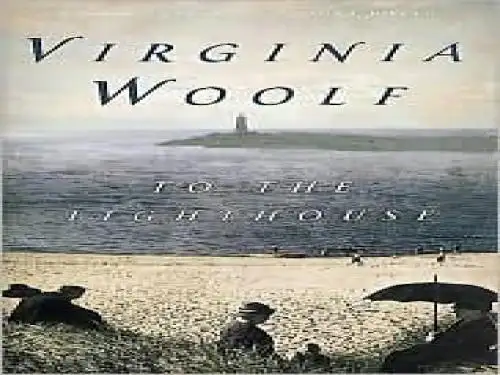
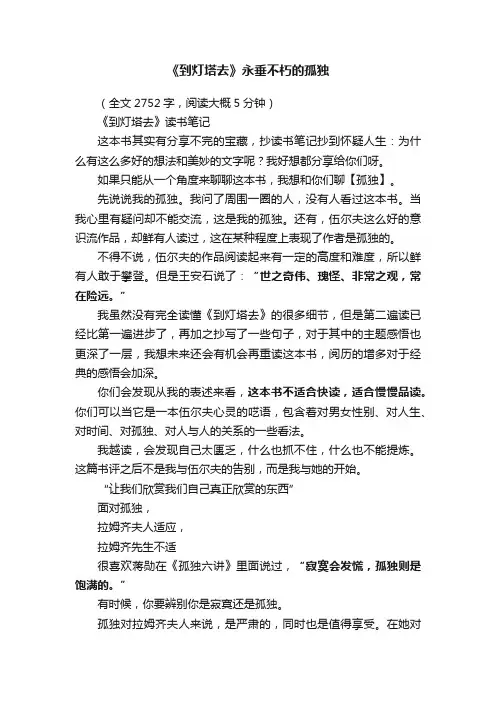
《到灯塔去》永垂不朽的孤独(全文2752字,阅读大概5分钟)《到灯塔去》读书笔记这本书其实有分享不完的宝藏,抄读书笔记抄到怀疑人生:为什么有这么多好的想法和美妙的文字呢?我好想都分享给你们呀。
如果只能从一个角度来聊聊这本书,我想和你们聊【孤独】。
先说说我的孤独。
我问了周围一圈的人,没有人看过这本书。
当我心里有疑问却不能交流,这是我的孤独。
还有,伍尔夫这么好的意识流作品,却鲜有人读过,这在某种程度上表现了作者是孤独的。
不得不说,伍尔夫的作品阅读起来有一定的高度和难度,所以鲜有人敢于攀登。
但是王安石说了:“世之奇伟、瑰怪、非常之观,常在险远。
”我虽然没有完全读懂《到灯塔去》的很多细节,但是第二遍读已经比第一遍进步了,再加之抄写了一些句子,对于其中的主题感悟也更深了一层,我想未来还会有机会再重读这本书,阅历的增多对于经典的感悟会加深。
你们会发现从我的表述来看,这本书不适合快读,适合慢慢品读。
你们可以当它是一本伍尔夫心灵的呓语,包含着对男女性别、对人生、对时间、对孤独、对人与人的关系的一些看法。
我越读,会发现自己太匮乏,什么也抓不住,什么也不能提炼。
这篇书评之后不是我与伍尔夫的告别,而是我与她的开始。
“让我们欣赏我们自己真正欣赏的东西”面对孤独,拉姆齐夫人适应,拉姆齐先生不适很喜欢蒋勋在《孤独六讲》里面说过,“寂寞会发慌,孤独则是饱满的。
”有时候,你要辨别你是寂寞还是孤独。
孤独对拉姆齐夫人来说,是严肃的,同时也是值得享受。
在她对外的一切付出都暂时告一段落后,拉姆齐夫人才可以松一口气。
“现在她再也不必顾忌任何人了。
她能够恢复她的自我,不为他人所左右了。
正是在现在这样的时刻,她经常感到需要——思索;嗯,甚至还不是思索,是寂静;是孤独。
所有那些向外拓展、闪闪发光、音响杂然的存在和活动,都已烟消云散;现在,带着一种严肃的感觉,她退缩回她的自我——一个楔形的黑暗的内核。
虽然她正襟危坐,继续编织正是在这种状态之中,她感到了她的自我;而这个摆脱羁绊的自我,是自由自在,可以在经历最奇特的冒险。
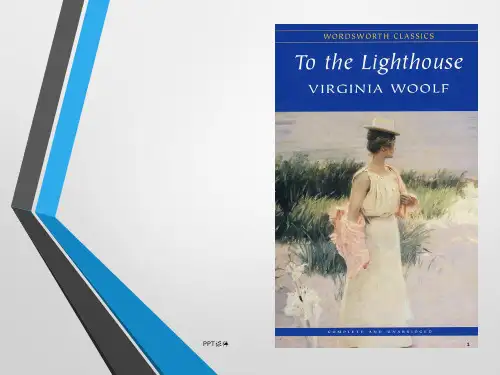
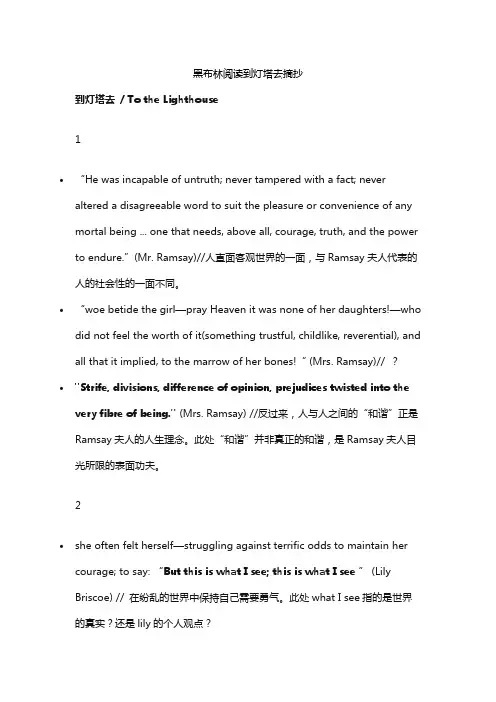
黑布林阅读到灯塔去摘抄到灯塔去/ To the Lighthouse1•“He was incapable of untruth; never tampered with a fact; never altered a disagreeable word to suit the pleasure or convenience of any mortal being ... one that needs, above all, courage, truth, and the power to endure.”(Mr. Ramsay)//人直面客观世界的一面,与Ramsay夫人代表的人的社会性的一面不同。
•“woe betide the girl—pray Heaven it was none of her daughters!—who did not feel the worth of it(something trustful, childlike, reverential), and all that it implied, to the marrow of her bones!“ (Mrs. Ramsay)// ?•"Strife, divisions, difference of opinion, prejudices twisted into the very fibre of being." (Mrs. Ramsay) //反过来,人与人之间的“和谐”正是Ramsay夫人的人生理念。
此处“和谐”并非真正的和谐,是Ramsay夫人目光所限的表面功夫。
2•she often felt herself—struggling against terrific odds to maintain her courage; to say: “But this is what I see; this is what I see ” (LilyBriscoe) // 在纷乱的世界中保持自己需要勇气。
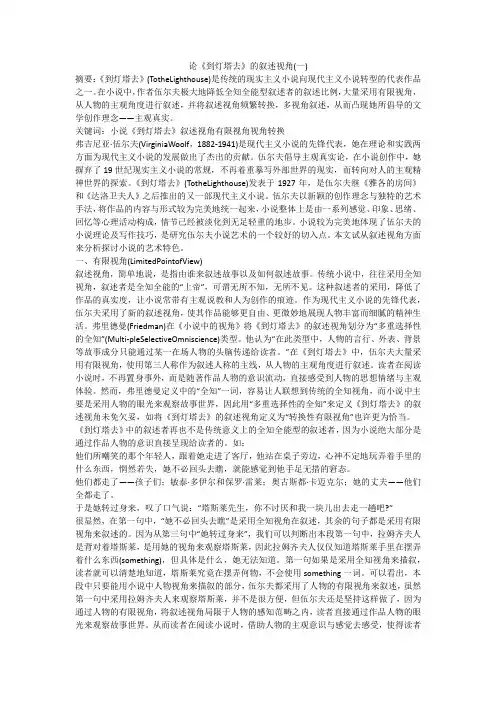
论《到灯塔去》的叙述视角(一)摘要:《到灯塔去》(TotheLighthouse)是传统的现实主义小说向现代主义小说转型的代表作品之一。
在小说中,作者伍尔夫极大地降低全知全能型叙述者的叙述比例,大量采用有限视角,从人物的主观角度进行叙述,并将叙述视角频繁转换,多视角叙述,从而凸现她所倡导的文学创作理念——主观真实。
关键词:小说《到灯塔去》叙述视角有限视角视角转换弗吉尼亚·伍尔夫(VirginiaWoolf,1882-1941)是现代主义小说的先锋代表,她在理论和实践两方面为现代主义小说的发展做出了杰出的贡献。
伍尔夫倡导主观真实论,在小说创作中,她摒弃了19世纪现实主义小说的常规,不再着重摹写外部世界的现实,而转向对人的主观精神世界的探索。
《到灯塔去》(TotheLighthouse)发表于1927年,是伍尔夫继《雅各的房间》和《达洛卫夫人》之后推出的又一部现代主义小说。
伍尔夫以新颖的创作理念与独特的艺术手法,将作品的内容与形式较为完美地统一起来,小说整体上是由一系列感觉、印象、思绪、回忆等心理活动构成,情节已经被淡化到无足轻重的地步。
小说较为完美地体现了伍尔夫的小说理论及写作技巧,是研究伍尔夫小说艺术的一个较好的切入点。
本文试从叙述视角方面来分析探讨小说的艺术特色。
一、有限视角(LimitedPointofView)叙述视角,简单地说,是指由谁来叙述故事以及如何叙述故事。
传统小说中,往往采用全知视角,叙述者是全知全能的“上帝”,可谓无所不知,无所不见。
这种叙述者的采用,降低了作品的真实度,让小说常带有主观说教和人为创作的痕迹。
作为现代主义小说的先锋代表,伍尔夫采用了新的叙述视角,使其作品能够更自由、更微妙地展现人物丰富而细腻的精神生活。
弗里德曼(Friedman)在《小说中的视角》将《到灯塔去》的叙述视角划分为“多重选择性的全知”(Multi-pleSelectiveOmniscience)类型。
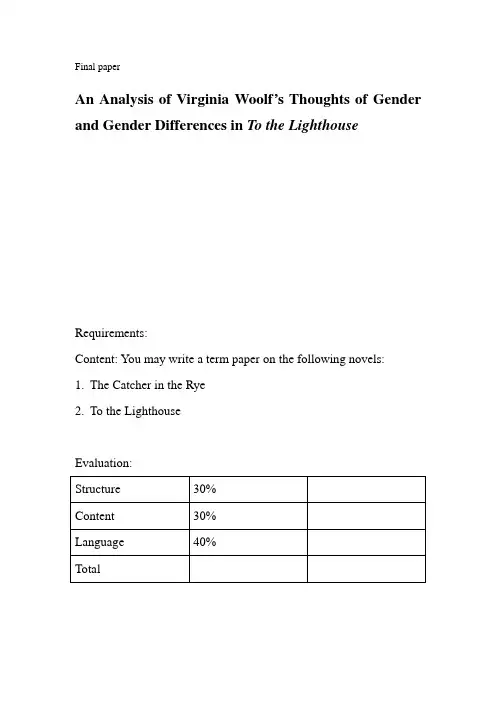
Final paperAn Analysis of Virginia Woolf’s Thoughts of Gender and Gender Differences in To the LighthouseRequirements:Content: You may write a term paper on the following novels:1.The Catcher in the Rye2.To the LighthouseEvaluation:Abstract:Virginia Woolf(1882-1941) is a renowned English writer best known for her novels and essays. To the Lighthouse is one of her great works. This paper is mainly study three issues: feminism, the understanding of gender and the thoughts of gender differences.摘要:弗吉尼亚. 伍尔夫(1882-1941)是一位以小说和散文而著名的英国作家。
《到灯塔去》是她的佳作之一。
本篇论文主要研究的三个问题是:女性主义,对于性别的理解以及有关性别差异的思考。
OutlineTitle: An Analysis of Virginia Woolf’s Thoughts of Gender and Gender Differences in To the LighthouseⅠ.IntroductionⅡ. Body:A.Woolf and feminismB.Woolf’s androgynous visionC.Gender differences1.Definition of gender difference2.Woolf’s thoughts of gender differencesⅢ. ConclusionⅠ. Introduction:Virginia Woolf was born Adeline Virginia Stephen on 25 January, 1882 inLondon. She was an English novelist and essayist, regarded as one of the foremost modernist literary figures of the twentieth century. Her most famous works include the novels Mrs. Dalloway(1925), To the Lighthouse(1927) and Orlando(1928) and the book-length essay A Room of One’s Own(1929) with its famous dictum, “ A woman must have money and a room of her own if she is to write fiction”Wang wenyan, a postgraduate of Hunan University in the paper Female Consciousness in To the Lighthouse analyzes two major female characters, Mrs. Ramsay and Lily Briscoe from the feminist criticism point of view. At first, she studies the growth of Virginia Woolf’s feminism and analyzes “Angel in the House”and “the undercurrent in Mrs. Ramsay”. This paper is very good at focusing on one topic that is Virginia Woolf’s feminism. It offers me some knowledge about feminism and makes me more familiar with this book.Cheng ying, a posts graduate from Zhengzhou University in her paper Virginia Woolf’s Art of Fiction in To the Lighthouse studies her typical stream-of-consciousness technique, musical methods, cinematic methods and poetic methods. And she mainly analyzes how these techniques used in the novel. Through reading this paper it is helpful for us to have a hint of Wool’f’s writing skills.Li songyue, a scholar of Zhengzhou University in his paper 《<到灯塔去>两性形象的象征意义阐述》he mainly studies the narrative strategy----symbolism and gender perspective. Through the comparison of different genders’ personality, action, thinking symbolic colors and finally comes out the conclusion that in the book To the Lighthouse some objects are the symbols of genders.But in this paper, what I want to study is gender and gender differences in the novel To the Lighthouse. I will talk about feminism, androgynous thoughts and genderdifferences in the novel.Ⅱ. Virginia Woolf’s Thoughts of Gender and Gender Differences in To the LighthouseA. Woolf and feminismFeminism is an intellectual, philosophical and political discourse aimed at equalrights and legal protection for women. It involves various movements, theories and philosophies, all concerned with issues of gender difference that advocate equality for women and that campaign for women’s rights and interests.Virginia Woolf’s feminist thoughts widely cover the fields of society, politics, ethics, aesthetics, etc. and the need for freedom for the female is the primary theme in her ethical scheme. Gender and politics, morality and psychological desire are mixed together inextricably in her presentation of human motivation. In spite of all of these, Virginia Woolf has never, even once in her life, admitted that she herself is an advocator for feminism and insists that what she did was just studying it. Here we can see the complexity of Woolf’s feminist position and the flexibility with which she may be read as a feminist.In To the Lighthouse, Mrs. Ramsay and Lily Briscoe are the two female figures that Woolf mainly describes. However, they impress the readers strikingly for their views about the way to realize their own dreams and to escape from nothingness. Through the reading of Woolf’s different descriptions of Mrs. Ramsay and Lily Briscoe, we may find Woolf’s thoughts of female in the novel.Mrs. Ramsay is a competent and intelligent housewife. She supports her husband by running the house smoothly and endures domestic anxiety alone so that the daily chores won’t interrupt Mr. Ramsay’s serious thoughts on reason and logic. She miraculously manages to run the house without disturbing her husband. The financial condition of the family is exposed by one of the guests, Mr. Bankes’ perception of the family. “The Ramsays were not rich, and it was a wonder how they managed to contrive it all. Eight children! To feed eight children on philosophy!” In fact, the wonder maker is Mrs. Ramsay. With herwisdom in housework she successfully shoulders the responsibility of house management without any help from her husband. Though she is worried about the household, she tries her best not to disturb him. The refrain of the bill for the greenhouse roof looms but she decides not to tell him. “She had it on the tip of her tongue to say, as they strolled, ‘It’ll cost fifty pounds,’ but instead, for her heart failed her about money, she talk ed about Jasper shooting birds …” Mrs. Ramsay feels it her obligation to keep the husband away from the worries of small daily family life.Being a good mother is another criterion of the ideal Victorian womanhood. Woolf depicts such a good mother in this novel. Mrs. Ramsay protects her children from disillusion. When her son, James hopes for a trip to the lighthouse the next day and the father declares bad weather, it is Mrs. Ramsay who insists upon the possibility of a clear day. In this way she protects the sensitive mind of the child, retaining hope and faith in him, which shows her reverence for the spirit in others. What’s more, Mrs. Ramsay also protects her children from the chaotic adult world. By intuition, she knows the world is full of misery and sufferings.Apart from Mrs. Ramsay, Lily is the other important female figure in To the Lighthouse. She admires and loves Mrs. Ramsay and shares a lot with her. However, their differences exceed their similarity. Compared with Mrs. Ramsay who is presented as an ideal woman of Victorian period, Lily represents the woman image of the new generation. She holds her unique views on marriage, which collides with the established and long standing Victorian customs of marriage. She develops her individual relationships with the opposite sex, which challenges the unitary relationship of marriage between the two sexes. She ventures into the career of painting, which has been the preserved domain of men. She courageously fights against any difficulties and obstacles that come in her way to self independence and self realization.B. Woolf’s androgynous visionAndrogyny is a term derived from two Greek words which can refer to either of two related concepts about gender: the mixing of masculine and feminine characteristics, as in fashion statements; or the balance of “anima and animus” in psychoanalytic theory. For Woolf, the psyche is composed of two parts, one male and the other female, and only when the two are fused into one will the mind be able to produce art.In Woo lf’s opinion, there exist two genders in human cerebrum –male and female and each pair forms a complementary whale. There is no apparent hierarchical order between them: the only dominance is the feminine part in the woman’s brain, and vice versa for man. Woolf’s choice of the word “fatal” is particularly important for an understanding of the high premium she places on androgyny. An importantaspect of Woolf’s argument for androgyny insists that writers should shun consciousness of their own sex when they write because pressures to conform to social gender roles create barriers that are “fatal” to creativity. She thinks that androgynous writing is not only an ideal, but also a reality. As for Woolf, “Perhaps a mind that is purely masculine cannot create, any more than a mind that is purely feminine”. She thinks that Shakespeare’s mind is a type of the androgynous of the man-womanly mind.C. Gender differences1. Definition of gender differenceThe term “gender difference” refers to a distinction of biologic al and/or physiological characteristics typically associated with either males or females of a species in general. In the study of humans, socio-political issues arise in classifying whether a sex difference results from the biology of gender. Some feminists see gender differences as caused by patriachy or discrimination, although Difference Feminism argues for an acceptance of gender differences. Conservative masculists tend to see gender differences as inherent in human nature, while liberal masculists see gender differences as caused by matriarchy or discrimination.2. Woolf’s thoughts of gender differencesWoolf’s thoughts of gender differences are formed through her understanding of the social prejudice towards all fields that related to women.There is no doubt that Woolf not only realizes the existence of gender differences and she also advocates protecting the existence. The gender differences are caused by two major aspects: the subjective social ideology that treats men and women differently and considers different genders should have different roles; and the objective existence of psychological and physical differences between different genders. These two aspects are respectively subjective cause and objective cause. In conclusion, the essence of Woolf’s thoughts of gender differences is: 1) admission of the existence of gender differences, in both subjective and objective aspects; 2) opposition to the subjective and prejudiced thoughts of genderdifferences; and 3) promotion of the objective gender differences and encouragement of the existence of such differences.In To the Lighthouse, Woolf presents clear portraits of male and femalecharacters. The characters she describes most carefully are Mr. Ramsay and Mrs. Ramsay. In the novel, the both Mr. Ramsay and Mrs. Ramsay want to create a harmonious atmosphere among people and try to be understandable to others. However, they have different outlooks on life and their attitudes and behaviors are also significantly different.In To the Lighthouse, Virginia Woolf discusses the influence of the traditional conception about different genders, which is the cause of gender differences. Mrs. Ramsay in the novel is the typical woman who is the slave fostered by men. Although she is not satisfied with the life of losing herself and lacking for self-confidence, she still worships her husband blindly, depends on her husband and subordinates to her husband. Besides playing the role of a virtuous wife and a lovely mother initiatively in the family and an elegant hostess in social situations, she still makes use of her influential power. Mrs. Ramsay does not only comply with social customs herself, she also impels others: she arranges for the marriage between Paul and Minta and tries to persuade Lily to marry Mr. Bankes. Under the influence of such traditional conception about different genders, Lily still feels that she can’t get rid of social prejudice to concentrate her attention on the art of painting although she is a woman having her own inclination. She always feels that she is just a second-class painter, and her works will not be hung on the wall to be seen by people. Furthermore, there is Mr. Tansley whispering in her ear, “Women can’t paint, women can’t write” obvious that her feeling of failure is caused by the influence of the traditional conception about different genders that women are inferior to men.Another great difference between different genders is that Mr. Ramsay is more realistic while Mrs. Ramsay more idealistic. This can be seen, in the very beginning of the novel, from the attitudes towards whether the Ramsays can go to the lighthouse the next day. Mrs. Ramsay says: “Yes, of course if it’s fine tomorrow, but you’ll have to be up with the lark,” then they will go to the lighthouse. These words convey an extraordinary joy to her son. But her husband comes over and refutes: “But, it won’t be fine”. What he says is the truth and the truth forever; he does not resort to deception and distort the fact, and he will not say some harsh words mildly and indirectly to satisfy others. Mrs. Ramsay comforts James: “But it may be fine –Iexpect it will be fine” (ibid.: 260). Although she has no idea about the weather of thenext day, Mrs. Ramsay is not only idealistic herself, but also wants to give her son comfort and hope. Mr. Ramsay, on the other hand, is not only rational as mentioned before, but also realistic, directly telling his son that the weather will not be fine and they can’t go to the lighthouse the next day. To Mr. Ramsay, the reality towers abo ve the rest, i.e., it’s much more important to respect the facts than to care for children. Therefore, his little son James is even anxious to kill him. As a philosopher, he may be skilled at explaining and dealing with everything in the world with his sense and logic. However, when he applies this kind of attitude to real life, such attitude seems so stubborn that he even denies human nature and suppresses others’ feeling, not only in his learning, but also in dealing with human relationship.The third difference between different genders lies in the aesthetic appreciations. Mr.Ramsay can’t feel the beauty of nature at all. In this novel, male characters come into society,engaging in scientific study. Thinking themselves as the creators of the culture, men talk about science and politics. Yet being deprived of the rights to receive education, women have to stay at home and stand beyond culture. Mr. Ramsay and Mrs. Ramsay have different reactions to the scenes of nature. For example, when Mr. Ramsay has a wal k with his wife by the seaside“he thought, looking at the land dwindling away… Poor little place,” but Mrs. Ramsay considers, “He said the mostmelancholy things,” and believes that “it was a perfectly lovely evening”.Ⅲ. ConclusionOn the whole, this dis sertation expounds on Virginia Woolf’s thoughts of gender and gender differences through the analysis of her thoughts of feminism manifested in her novel To the Lighthouse. From our analysis of the characters in the novel To the Lighthouse, we can see that Woolf’s perspective of women is unique. According to Woolf, women are not inferior to men in any field.In my opinion, the basis of Virginia Woolf’s androgynous theory has something in common with her thoughts of gender differences to a certain extent. Androgynous theory advocates that men and women command the chaotic world in their own way: men rely on their reason and logic; women rely on their intuition and self-awareness. In fact, what Woolf insists as part of her thoughts of gender differences is that mentend to be more reasonable than women and women more sensitive than men. In addition, Woolf’s thoughts of gender differences can be regarded as a bridge, connecting Woolf’s thoughts of feminism and androgynous vision.Virginia Woolf’s thoughts of wom en still have practical significance in our modern society. Nowadays, women’s social position has been greatly improved, but there are many unfair treatments of women in the society, especially in finding jobs. There are many women isolated in their families after marriage, which is partly caused by their insufficient confidence in themselves. So it is time to get rid of the biased thoughts of gender differences about women and women themselves should believe that they can do many things like men. However, as a matter of fact, women should realize that they have both advantages and disadvantages. In this sense, women should not reject all male qualities and they need to absorb some male qualities to become perfect ones. In this way, women and men can draw the strong points of others to offset their own weakness, so that our society can get a harmonious development. In short, Virginia Woolf has made a great contribution to English literature and she will always be remembered as one of the most prominent women writers in England forever.Reference[1] 程英. Art of Fiction in To the Lighthouse [D].郑州:郑州大学,2002[2]李嵩岳. 《到灯塔去》两性形象的象征意义阐述[D]. 郑州,郑州大学,2009 [2] 吴庆宏. 弗吉尼亚伍尔夫与女权主义[M]. 北京: 中国社会科学出版社, 2005.[4]. 王文艳. 《到灯塔去》中的女性意识[D].长沙:湖南师范大学,2001。


从《到灯塔去》象征意义看其艺术价值《到灯塔去》是英国作家弗吉尼亚·伍尔夫于1927年出版的小说。
它以美丽而复杂的叙事风格打动了无数读者,并被誉为20世纪的一部文学经典。
通过对小说中灯塔的象征意义的深入探讨,我们可以揭示其所蕴含的丰富的艺术价值。
小说的开篇描绘了一个充满活力的家庭度假,而夏洛特·布兰特将这次度假与到灯塔的旅行相联系。
灯塔作为小说的核心象征,代表着人们对灵感、觉醒和归属的渴望。
它象征着创造力的追求和灵魂的升华。
当布兰特一家人将灯塔作为目的地时,实际上也是在追寻内心的未知和探索个体与自然世界的联系。
在小说中,灯塔的光辉象征着真理的启示与智慧的光芒。
对于主人公夏洛特·布兰特来说,灯塔是她梦寐以求的归宿,也代表了她对认知和认识自我的探索。
她将灯塔视为一种象征,一种可能性的延伸,一种对生活和意义的理解。
而对于其他人物来说,灯塔则象征着他们对美丽、真理和内心真实性的追求。
每个人对灯塔的理解和感悟都不同,这给了小说以丰富的文化内涵。
在《到灯塔去》中,灯塔象征着人类对更高境界的追求。
布兰特一家人经历了一次次的挫折、磨难和人生转折点,但灯塔的存在带给了他们内心的净化与安宁。
通过到灯塔的旅行,布兰特一家人逐渐意识到人生的真正意义和美好。
通过灯塔的象征,伍尔夫成功地将这种人性的追求融入到作品中,展示了生命的价值与意义。
此外,《到灯塔去》还通过灯塔的象征意义揭示了时间与存在的关系。
灯塔作为一个定格在时间之外的存在,代表着永恒和不变。
它超越了时间的流逝,使人们对生命的脆弱和时间的有限有了更深刻的思考。
在小说中,布兰特一家人对灯塔的追求具有极强的审美意义,同时也是对人生瞬息万变的时间流逝的抗争与追忆。
总之,从《到灯塔去》中灯塔的象征意义来看,这部小说具有诸多的艺术价值。
通过灯塔,作家弗吉尼亚·伍尔夫成功地展示了人类对创造力、觉醒和归属的追求,探讨了真理与智慧的启示,揭示了时间与存在的关系。
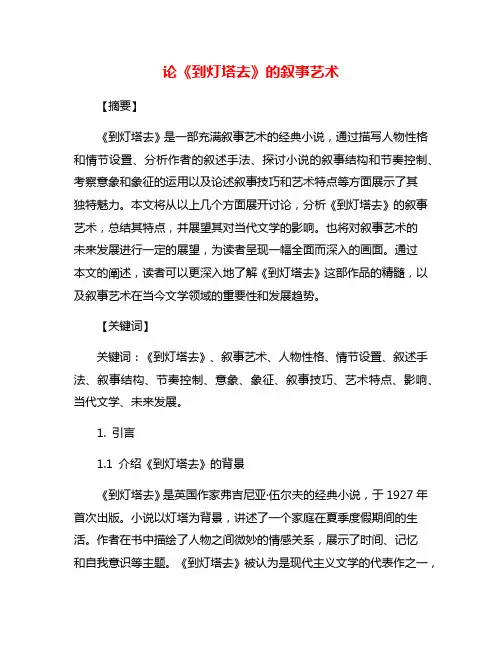
论《到灯塔去》的叙事艺术【摘要】《到灯塔去》是一部充满叙事艺术的经典小说,通过描写人物性格和情节设置、分析作者的叙述手法、探讨小说的叙事结构和节奏控制、考察意象和象征的运用以及论述叙事技巧和艺术特点等方面展示了其独特魅力。
本文将从以上几个方面展开讨论,分析《到灯塔去》的叙事艺术,总结其特点,并展望其对当代文学的影响。
也将对叙事艺术的未来发展进行一定的展望,为读者呈现一幅全面而深入的画面。
通过本文的阐述,读者可以更深入地了解《到灯塔去》这部作品的精髓,以及叙事艺术在当今文学领域的重要性和发展趋势。
【关键词】关键词:《到灯塔去》、叙事艺术、人物性格、情节设置、叙述手法、叙事结构、节奏控制、意象、象征、叙事技巧、艺术特点、影响、当代文学、未来发展。
1. 引言1.1 介绍《到灯塔去》的背景《到灯塔去》是英国作家弗吉尼亚·伍尔夫的经典小说,于1927年首次出版。
小说以灯塔为背景,讲述了一个家庭在夏季度假期间的生活。
作者在书中描绘了人物之间微妙的情感关系,展示了时间、记忆和自我意识等主题。
《到灯塔去》被认为是现代主义文学的代表作之一,对后世文学产生了深远影响。
该小说以其深刻的思考和独特的叙事风格,吸引了广泛的读者群,并被誉为伍尔夫最重要的作品之一。
在这部作品中,作者通过精致的描写和复杂的情节设置,展现了现代人内心深处的孤独和迷茫,引领读者深入思考人生和存在的意义。
1.2 阐述叙事艺术的重要性叙事艺术是文学作品中至关重要的一部分,它通过人物塑造、情节设置、叙述手法等方面的运用,引导读者进入作品的世界,深化对主题和情感的理解。
叙事艺术不仅是文学作品的表现形式,更是作者传达思想和情感的有效途径。
通过精妙的叙事艺术,作品能够引起读者的共鸣和思考,进而影响他们的情感和思想。
叙事艺术在文学作品中的重要性不可低估。
它不仅能够使作品更具观赏性和深度,更能够引发读者的思考和共鸣,进而影响他们的情感和观念。
一个成功的文学作品离不开精湛的叙事艺术,只有通过艺术的叙述,作品才能真正触动读者的心灵,留下深刻的印记。
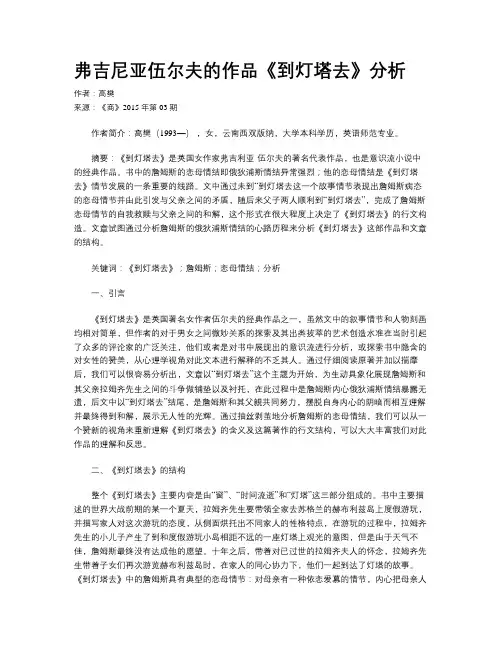
弗吉尼亚伍尔夫的作品《到灯塔去》分析作者:高樊来源:《商》2015年第03期作者简介:高樊(1993—),女,云南西双版纳,大学本科学历,英语师范专业。
摘要:《到灯塔去》是英国女作家弗吉利亚·伍尔夫的著名代表作品,也是意识流小说中的经典作品。
书中的詹姆斯的恋母情结即俄狄浦斯情结异常强烈;他的恋母情结是《到灯塔去》情节发展的一条重要的线路。
文中通过未到“到灯塔去这一个故事情节表现出詹姆斯病态的恋母情节并由此引发与父亲之间的矛盾,随后来父子两人顺利到“到灯塔去”,完成了詹姆斯恋母情节的自我救赎与父亲之间的和解,这个形式在很大程度上决定了《到灯塔去》的行文构造。
文章试图通过分析詹姆斯的俄狄浦斯情结的心路历程来分析《到灯塔去》这部作品和文章的结构。
关键词:《到灯塔去》;詹姆斯;恋母情结;分析一、引言《到灯塔去》是英国著名女作者伍尔夫的经典作品之一,虽然文中的叙事情节和人物刻画均相对简单,但作者的对于男女之间微妙关系的探索及其出类拔萃的艺术创造水准在当时引起了众多的评论家的广泛关注,他们或者是对书中展现出的意识流进行分析,或探索书中隐含的对女性的赞美,从心理学视角对此文本进行解释的不乏其人。
通过仔细阅读原著并加以揣摩后,我们可以很容易分析出,文章以“到灯塔去”这个主题为开始,为生动具象化展现詹姆斯和其父亲拉姆齐先生之间的斗争做铺垫以及衬托,在此过程中是詹姆斯内心俄狄浦斯情结暴露无遗,后文中以“到灯塔去”结尾,是詹姆斯和其父親共同努力,摆脱自身内心的阴暗而相互理解并最终得到和解,展示无人性的光辉。
通过抽丝剥茧地分析詹姆斯的恋母情结,我们可以从一个赞新的视角来重新理解《到灯塔去》的含义及这篇著作的行文结构,可以大大丰富我们对此作品的理解和反思。
二、《到灯塔去》的结构整个《到灯塔去》主要内容是由“窗”、“时间流逝”和“灯塔”这三部分组成的。
书中主要描述的世界大战前期的某一个夏天,拉姆齐先生要带领全家去苏格兰的赫布利兹岛上度假游玩,并描写家人对这次游玩的态度,从侧面烘托出不同家人的性格特点,在游玩的过程中,拉姆齐先生的小儿子产生了到和度假游玩小岛相距不远的一座灯塔上观光的意图,但是由于天气不佳,詹姆斯最终没有达成他的愿望。
论《到灯塔去》的象征艺术【摘要】《到灯塔去》这部小说是一部充满象征意义的作品,其中的灯塔、海、光线、孤独和航标等元素被赋予深刻的象征意义。
作者通过这些象征来探讨人生的意义、追寻内心的真实和抗拒现实的挑战。
灯塔象征着希望和指引,海象征着无限可能和未知,光线象征着真理和启示,孤独象征着内心的孤独和挣扎,航标象征着前行的方向和目标。
通过对这些象征的分析和解读,我们可以更好地理解小说中的含义,探讨现实与理想的关系,并发现作品的深厚艺术价值。
《到灯塔去》不仅是一部文学作品,更是一部思想的探索和灵魂的启示。
【关键词】《到灯塔去》,象征艺术,灯塔象征,海象征,光线象征,孤独象征,航标象征,艺术价值,现实联系,总结。
1. 引言1.1 《到灯塔去》的背景介绍《到灯塔去》是英国作家弗吉尼亚·伍尔夫(Virginia Woolf)于1927年出版的小说,是她的代表作之一。
这部小说以灯塔为主要场景,讲述了一家人在灯塔度假的故事。
灯塔是指一座位于海岸边的巨大建筑物,用来引导航海者航行。
在小说中,灯塔象征着远方的希望和理想,也代表着人们对未来的向往和探索。
作者通过描绘灯塔的景象和意义,展现了人类对于事物意义和存在的追求。
《到灯塔去》在当时引起了广泛的关注和好评,被认为是一部充满象征意义和思考的文学作品。
作品中描绘的家庭生活、人际关系以及对自我和外部世界的探索,都体现了作者对人类内心深处和情感世界的敏锐洞察力。
通过对灯塔的象征化处理,作者使得小说中的人物和情节更加深刻和丰富,给读者留下了深刻的印象。
《到灯塔去》的背景介绍为读者提供了对小说整体主题和意义的初步了解,也为后续正文中具体象征意义的探讨奠定了基础。
1.2 《到灯塔去》的作者简介《到灯塔去》的作者是英国作家弗吉尼亚·吴尔夫(Virginia Woolf)。
吴尔夫生于1882年,在20世纪初是一位备受瞩目的现代主义作家。
她以其独特的文体和对人类内心深处的刻画而闻名于世,被认为是20世纪英国文学史上最伟大的小说家之一。
g肴弄I文化与教育从女性主义角度赏析伍尔芙《到灯塔去》杜丹妮摘要:英国著名女作家弗吉尼亚•伍尔芙是意识流小说家的代表之一,同时也是女性主义的开拓者之伍尔芙的经典小说作品《到灯塔去》,借助于莉莉这一人物形象的刻画,阐明了女性主义的真谛,为当时社会背景中的妇女解放提供了一条新的道路.在这部小说中,揭示了以男权为核心的社会环境中的女性生存现状,表明了作者希望建立一个生态平衡,两性和谐的社会构想。
本文通过分析《到灯塔去》中拉姆齐夫人和莉莉的人物形象,从女性主义角度对这部作品进行了赏析。
关键词:女性主义;《到灯塔去》;赏析一、伍尔芙的女性主义思想伍尔芙是20世纪最为著名的女作家之一,其小说作品受到了诸多关注,而她的《到灯塔去》可以说是女性主义和意识流小说的代表之作。
女性主义思想自其诞生之日开始就得到了较快的发展,在20世纪60年代开始掀起了第二股浪潮,随后伍尔夫就着重研究关于女性主义思想的问题,将这一理念融入自己的小说作品中,让其很多作品都蕴含了十分丰富的女性精神,也具备更加深层次的社会内涵。
但应当认识到的一点是,伍尔芙女性主义思想的发展不单单和当时社会背景相关,也在一定程度上受到了家庭环境的影响。
伍尔芙的父亲是当时非常著名的学者,所以家中也常常组织学术聚会,她从小在潜移默化中受到了很多学者先进思想的影响,让她的眼界得以开阔。
因为伍尔芙天资聪慧,为我们贡献了很多精彩的小说作品。
但伍尔芙一生却是坎坷的,她在年幼时受到同母异父兄弟的侵犯,这对于她的人生也造成了非常大的阴影,从而让其对性与婚姻都表现出较大的恐惧,但是负面情绪并未对她的创作带来较大影响,反而让其能够更加沉浸在写作中,真实客观的表达出自己的思想与观点,因此她的小说作品中也能够更多的包含了当时男权社会背景下女性基本权利的丧失,而这些也充分展示了当时女性的悲剧以及之后女性主义的觉醒和发展。
二、《到灯塔去》中的女性主义思想(_)拉姆齐夫人---男权维护者拉姆齐夫人是小说中的经典人物,在伍尔芙的笔下,将拉姆齐夫人刻画成了“屋中天使”的形象,她作为哲学教授的妻子,同时也是八个孩子的母亲,其外表具有高贵的气质与出众的容颜,但她的日常生活却是非常枯燥的。
本文由felicity_ct贡献pdf文档可能在WAP端浏览体验不佳。
建议您优先选择TXT,或下载源文件到本机查看。
永远的灯塔———象征主义在《到灯塔去》中的运用王晓玲( 南京航空航天大学南京 210016)一( o 《到灯塔去》 T the Lighthouse ) ( 1927 ) 是弗吉会了游泳……他有一个叔叔在远离苏格兰海岸的某处礁石看守过灯塔 , ……他自己在塔中经历过风暴”所以对他而言灯塔是一种现实的存在 ,它是大海的咆哮 , 死亡的威胁。
所以当女画家莉丽提出要和他一起去灯塔时 , 他的回答总是一个“你 : 会受不了的。
灯塔和海水不能引起他任何美好的”联想和憧憬。
对于拉姆齐夫人 , 夜色里那远处闪烁不停的灯塔是那么的美丽“啊 , 多么美丽 ! 因为她眼前 , 是一片蓝色的海水 ; 那灰白色的灯塔显得如此遥远和庄严 ,它坚挺地屹立在水中……在她眼中灯”塔象征着一种宁静和详和 ,一种永恒 ,也是她得以施爱和救世的理想境地。
小说中灯塔的光芒也常与夫人联系在一起“时常她发现自己坐在那儿眺 , 望着 ,坐着 ,望着 ,手里还拿着她的活计 ,直到她与眺望的东西———如那灯光融为一体。
很明显夫人”本身就象征着关爱之光普照在每个人身上 , 她坐在窗前 ,遥望着灯塔 ,一边编织着袜子“如果她今 , 天能完工 ,如果明天他们果真去灯塔 ,这 ( 袜子 ) 是送给看塔上的儿子的……应该给他们尽可能的安慰。
而在另一种意义上讲 , 灯塔又象征着夫人内”心的孤独。
灯塔永远是孤零零地耸立在茫茫的大海之中 ,拉姆齐夫人却孤独地生活在人群里 ,尽管她整天地忙碌着 ,关心着她的家人和朋友 ,但她的内心是孤单的 ,她从不向人敞开心扉 ,包括她的丈夫 ,她就是一座孤独、自傲的灯塔 , 是难以到达的目的地。
而对拉姆齐先生来说 ,灯塔矗立在大海之中 ,尼亚? 伍尔夫意识流小说趋于成熟的一部代表作 , 是一部具有浓郁象征主义色彩的小说。
to the lighthouse英文阅读(中英文实用版)To The Lighthouse, a masterpiece by Virginia Woolf, is a novel that explores the complexities of human consciousness and the passage of time. Set in the early 20th century, the story revolves around the Ramsay family and their summer visits to the Isle of Skye in Scotland. Woolf's stream-of-consciousness technique takes readers deep into the minds of the characters, revealing their thoughts, emotions, and perceptions.《到灯塔去》是弗吉尼亚·伍尔夫的杰作,这部小说探讨了人类意识的复杂性和时间的流逝。
故事背景设定在20世纪初,围绕拉姆齐一家在苏格兰斯凯岛的夏日度假展开。
伍尔夫的意识流手法将读者带入角色的内心世界,展现了他们的思想、情感和感知。
The novel is divided into three parts, \'The Window,\' \'Time Passes,\' and \'The Lighthouse,\' each offering a unique perspective on the passage of time and the human experience. Woolf's poetic prose and symbolic imagery create an atmosphere that mirrors the ebb and flow of life, as well as the elusive nature of truth and reality.小说分为三个部分:“窗”、“时间流逝”和“灯塔”,每个部分都提供了关于时间流逝和人类经历的独特视角。